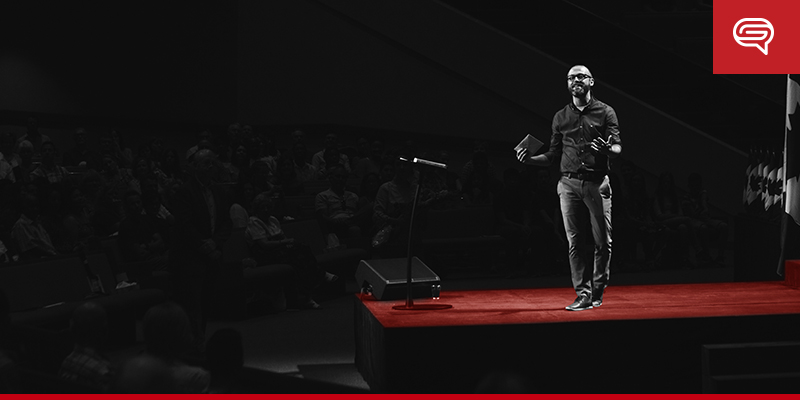The power of consistent branding is unrivaled.
Think about the Golden Arches of McDonalds, the iconic iPhone from Apple, or Nike’s “Just Do It” slogan. All it takes is a symbol or a few words to stimulate much broader thoughts about what these companies offer.
That’s the power of a well-branded company.
Most companies have the nuts and bolts of their brand, but have a hard time assembling them into a well-oiled machine.
Here are some of the most common mistakes holding them back:
Mistake #1: You Don’t Have a Brand Champion
Every brand needs a champion.
Find someone with a clear vision of what your brand should be and put them in a position to execute—President, Chief Marketing Officer (CMO), or a similar position.
When most people think of Apple, they think of Steve Jobs. The man is synonymous with the brand, despite having passed away. Why? Because he was the foremost brand champion for the company. His iconic blue jeans and black turtleneck mirrored the clean lines and polished design of Apple products. The way he spoke was indicative of Apple’s focus on innovation.
Jobs saw Apple’s brand as something to harness and he turned it into the monolithic company it is today.
It takes a true brand champion to recognize the potential and take the right steps to realize it. Find a person who’s passionate about your brand and put them in the pilot’s seat.
Mistake #2: You Have an Inconsistent Brand Identity
Brands are built by their consistency.
No matter where you look, everything from the colors, logos, verbiage and imagery are uniform to the brand without any deviation. That repetition is the key to association within the minds of consumers.
The more people see a uniform, coordinated message the easier it becomes for them to familiarize who and what they stand for. Using outdated assets, poor visuals, or disorganized concepts will only drag you down.
The easiest way to establish a consistent brand presence—which certainly includes company presentations—is to create and strictly adhere to guidelines.
Define every single aspect of your brand, down to the smallest details. Some facets to identify include:
- Voice. What type of voice does your brand project? Authoritative? Funny? Whimsical? Trustworthy? If your brand were a person, the tone of voice is how it would present itself.
- Color palette. What colors represent your brand? Pick a palette and stick to it across all branded materials. Use CYMK or Hex color codes to ensure every hue is the same.
- Logos. Define your logo and any alternate logos. Make sure everything from color and font to proportions and angles are all characterized.
- Typography. What fonts are acceptable for your brand? Serif or sans-serif? Do you have primary, secondary, and tertiary fonts? What size lettering is acceptable?
- Imagery. Determine the types of imagery acceptable to use in conjunction with your brand. Delineate things like image type and content, as well as resolution and licensing.
All these factors should come together in a comprehensive and cohesive brand style guide. Anyone who represents your brand in any way should have access to the style guide and refer to it frequently. If you ever evolve or update, so should the guide. It’s your branding bible!
Mistake #3: You’re Holding Back Your Creative Experts
Look at a LEGO. There’s nothing complicated about blocks that connect together.
The product itself isn’t necessarily exciting either. But what is exciting—and the reason LEGO has maintained popularity for more than 80 years—is the creativity behind the brand. Beyond the various LEGO sets themselves, the brand exudes limitless imaginative appeal.
Just by looking at Legoland, a theme park brimming with creativity, you’ll already see from their social profiles how much ingenuity the LEGO team has! They’ve built life-sized cars, near life-like sculptures, and recreated iconic movie scenes using only LEGOs.
They continuously showcase the power of the product in ways that inspire imagination and connect that feeling with the brand.
LEGO has built its brand beyond just blocks, doing so with unmatched creative action. Whether it’s building life-sized replicas out of LEGOs or creating exciting brand collaterals, the concept is the same: Put creatives in a position to succeed.
RELATED: How to Effectively Support Busy Graphic Design Teams
Mistake #4: You’re Wasting Your Design Team’s Time
Do your designers work overtime making mundane updates to existing content, like a brochure or flyer?
If that’s the case, then they’re not properly utilizing their talents. It could be limiting your company’s reach and costing you on the bottom line.
Designers are a core asset in brand building…don’t squander them!
As a rule of thumb, your design process should never be boring. If your designers are toiling away at their computers producing content that looks like everything else, your brand can hardly stand apart.
Conversely, if they’re excited about creating something unique, there’s a good chance it’ll contribute to the strength of your brand. Don’t waste their time or skills with a thousand little tweaks to a piece of collateral that’s a one-time pitch.
Instead, focus their passion on the larger concept and encourage them to create diverse collateral that fuel your business’ many branding efforts.
Mistake #5: Your Content Creation Rate is Too Slow
If your brand is locked down to the point that it stifles new content creation, corporate marketing will turn into a bottleneck. You’ll acquire a perception of being outdated and irrelevant within your industry.
You need to open the floodgates and create a consistent cadence that continually pumps life into your marketing efforts.
Take Pepsi, for example.
The company doesn’t roll out new products every few months—instead, it rolls out new content daily. There’s always a new commercial, contest, social media posts, and so on. At some point during the day, a person is going to come into contact with Pepsi in a way they haven’t before.
When they do, the brand’s strength grows. Even if that person doesn’t drink Pepsi, they know and respect the power of the brand.
You don’t have to create content every day, but make sure you’re generating new, quality, engaging content often enough to stay relevant in the eyes of your target audience.
Mistake #6: Your Brand is Static
The marketplace constantly evolves, as do your target customers.
As a result, your brand must be dynamic. You must recognize important shifts and evolution in your market, and refine your brand so it reflects these changes. The value proposition you project today may not be the one you focus on tomorrow.
Look at Walmart, for example. For years, Walmart’s main brand proposition focused on lower prices—but that’s not its chief message today.
Today, it’s all about convenience. Walmart is building brand equity through convenience—offering an in-store grocery, curbside pickup, and robust online shopping experience. The message has evolved. “I’ll go to Walmart because it’s cheaper” has become “I’ll go to Walmart because it’s convenient.”
They have grown stronger because they have adapted.
Mistake #7: Your Branding Overemphasizes Sales
Modern audiences won’t give your brand the time of day if you only seem interested in their money.
People want to choose to spend their money on you, not feel bullied into it. An approach that’s too aggressive will get stonewalled. Opt for an approach that’s relatable first and foremost.
Starbucks doesn’t push people to buy coffee or hound them into spending money. You can walk right into a Starbucks, grab a seat, and hang out without ordering anything at all! Starbucks’ brand isn’t wrapped up in selling coffee. It’s focused on welcoming people. Customers spend money because they want to, not because they’re asked to.
They have found success outside of sales, and in a roundabout way, that’s what drives its sales.
RELATED: Boost Sales Presentation Effectiveness Using Basic Marketing Principles
Mistake #8: You Don’t Understand Your Target Audience
This is marketing 101, which is why we saved it for last. We constantly see companies that don’t truly know their target audience.
A brand should fill a niche in someone’s life. For you to stand out, understand your target audience and communicate a clear value proposition to them.
Successful companies don’t just understand their audience at a surface level—they understand the values of their customers and the journey they’ll take in connecting with the brand. McDonald’s doesn’t just sell hamburgers. They sell hamburgers to single moms on-the-go who need to grab a quick bite for their kids on the way home from school. McDonald’s goes beyond their products, forming an identity their target audience relate to.
Get to know your target audience and work backward from their needs, wants, challenges, and values. The more you align with their lifestyle, the more trustworthy and established your brand becomes.
Don’t Make These Classic Mistakes
Building these things takes patience and focus. Most importantly, it means avoiding the common mistakes that hamper even the best efforts. Pay attention to these mistakes and focus on creating your brand through consistent, concerted effort.
Staying true to the brand you’re trying to build goes a long way in making it a reality.

















